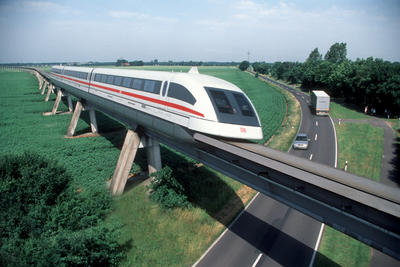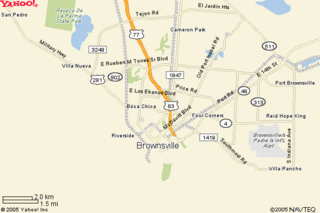MAGLEV Connecting the RGV & San Antonio
I wake up at 5:30am ready to go to work, which starts at 8:00am. By 6:30am I'm ready and off I go. But work isn't in Brownsville, but in San Antonio! How's that possible? It takes roughly four hours by car to get there and a plane ride every day would be cost prohibitive. A regular rail line wouldn't cut it either because the faster rail line in the U.S is the Amtrack Acelera at 150 mph tops. So how do I get to San Antone in a mere 55 minutes?
I'm glad you asked! Welcome to the 21st century where trains lo longer have to run on a track but instead on a cushion of air! This is not theory or fantasy. It exists today and China already has one connected from the airport to downtown. This kind of train is called a MAGLEV Train (Magnetically Levitated Train). How does it work? Well, it's a little technically invloved but here's the untechnical version of how it works (if there is such a thing as untechnical):
Before explaining the workings of a Maglev, I had built one very similar to it at UTB for my Senior Design class in the Electrical Engineering Technology degree. So I know for a fact that it exists and is already in use. In fact, the technology has been around for about forty years! The train I based my project on is the Transrapid 007 built by, of course, the Transrapid Company located in Germany. Here's the company's version of how their system works:
The Levitation System
Electronically controlled support magnets located on both sides along the entire length of the vehicle pull the vehicle up to the ferromagnetic stator packs mounted to the underside of the guideway.
Guidance magnets located on both sides along the entire length of the vehicle keep the vehicle laterally on the track. Electronic systems guarantee that the clearance remains constant (nominally 10 mm). To hover, the Transrapid requires less power than its air conditioning equipment. The levitation system is supplied from on-board batteries and thus independent of the propulsion system. The vehicle is capable of hovering up to one hour without external energy. While travelling, the on-board batteries are recharged by linear generators integrated into the support magnets.
Quicktime-Movie levitation System (42 KByte)
Flash-Film levitation System (40 KByte)
Propulsion System
Propulsion System Animation:
Real-Video Movie (80 KByte)
The GuidewayThe Transrapid hovers over a double track guideway. It can be mounted either at-grade or elevated on slim columns and consists of individual steel or concrete beams up to 62 m in length.
The Transrapid maglev system changes tracks using steel bendable switches. They consist of continuous steel box beams with length between 78 m and 148 m (256 ft - 486 ft) which are elastically bent by means of electromagnetic setting drives and securely locked in their end positions.
In the straight position, the vehicle can cross the switch without speed restrictions, in the turnout position, the speed is limited to 200 km/h (125 mph) (high speed switch) or 100 km/h (62 mph) (low speed switch).
The Vehicles
Transrapid vehicles comprise a minimum of two sections, each with approx. 90 seats on average. According to application and traffic volume, trains may be composed of up to ten sections (two end and eight middle sections).
However, the Transrapid is suitable for transporting goods as well. For high-speed cargo transport, special cargo sections can be combined with passenger sections or assembled to form dedicated cargo trains (payload up to 15 tons per section). As the propulsion system is in the guideway, neither the length of the vehicle nor the payload affect the acceleration power.
The Operation Control System
The operation control system controls the operation and guarantees the safety of the Transrapid system. It safeguards vehicle movements, the position of the switches, and all other safety and operational functions. Vehicles location on the track is accomplished using an on-board system which detects digitally encoded location flags on the guideway. A radio transmission system is used for communication between the central control center and the vehicles.
A MAGLEV Bewteen the RGV and San Antonio
Before I could get to the story I want to tell, you all had to know the basics about the how this Maglev works. Unfortunately, this Blog only allows one picture. To see the actual page from where I got the above info and understand it better with pictures, please go here: http://www.transrapid.de/en/information/technik_txt.html
Now, to the story. A Maglev is capable og traveling up to 350 mph and achieving higher speeds every few years. Speed is the key here if it is to compete with the airliners. My idea then is to connect Brownsville to Harlingen and then on to McAllen. Eventually, a line would connect Harlingen with San Antonio either via US Hwy 77 or through a more direct route.
The Route
The beauty of this Maglev is that it can be built as a monorail, where the train (not an accurate description of a floating train but it will suffice for now) would litterally be built above ground towering over most structures, say three stories so as to reduce the amount of space required on ground. Very similar to the picture I posted above. The Magalev would begin at the new Multi Modal Terminal (A good topic for next time) that will be built in downtown Brownsville right across the Tandy building at UTB along International Blvd. Since the terminal will be servicing all bus companies in one building, why not the Maglev? It's close to the university where thousands call home for most of the day and even students from SA can come to take classes and return home very conviniently and vice versa! From here the track will rise above most buildings in downtown and then head towards the Expressway 77/83 via the 6th and 7th St. then follow the expressway north to Harlingen. Before leaving Brownsville, it would make one more stop near the Sunrise Mall.
A transfer station would have to be built there. This way, the train can pick up or drop of people and then head towards Harlingen's dowtown or very near it. The maglev would only reach 200 mph between cities because it would require some amount of time to slow down but definately faster than a car at legal speeds! Basically, it would take roughly 12 1/2 minutes to get there along the expressway. Another transfer station would then need to be build right off the expressway, say near the Harlingen Valle Vista Mall. At this point, you would have two choices, go north to SA or west to McAllen. Let's just say we are going to McAllen this time. From Harlingen, the Maglev would not stop until it reached McAllen; another roughly 35 miles. At this point, the train would reach speeds of up to 250 mph in just about a few miles and arrive at McAllen's downtown's Multi Modal Bus station just as in Brownsville. The train would arrive in about 14 minutes. It's conviniently located between the Mall and the downtown area. The transfer time would be about eight minutes so the total time required to arrive to McAllen from Brownsville would be about 30 minutes. A full half hour or more off versus traveling by car!! The time savings would even be moe if you factor in vehicle traffic, clogs, and crashes that cause, at times, to close the entire expressway and getting rerouted. The upper valley really suffers a lot of traffic jams and road rage. So why bother driving when you can "fly" very conveniently to your destination? Even take a bkie with you to reach your final destination.
Suppose now that you are headed to work in SA. The first leg of the trip would be the same. 12 1/2 min to Harlingen. From there, you take the route to SA. There would be no stops in between Harlingen and SA. The maglev would travel up to 300 mph along Highway 77 and then via I-37 to SA. Total time would be about 55 minutes! The ride is very smooth as the train does not touch the guideway at all. The scenery would be fantastic and no more road rage. You sit back and enjoy the scenery. Get to SA, go to work, and finally come back home. No hassels at an airport, no losing luggage, delays, taking off you shoes, etc, etc.
With a maglev system in place that connects the RGV and with SA (maybe even all the way to Dallas) Texas could litterally be traversed in just a few hours without ever leaving the ground!! People could go to work in far off cities and come back home in time for dinner. Now that's the future!! All this is possible with the Maglev. Transportation in the 21st century just got a little faster.



.jpg)
